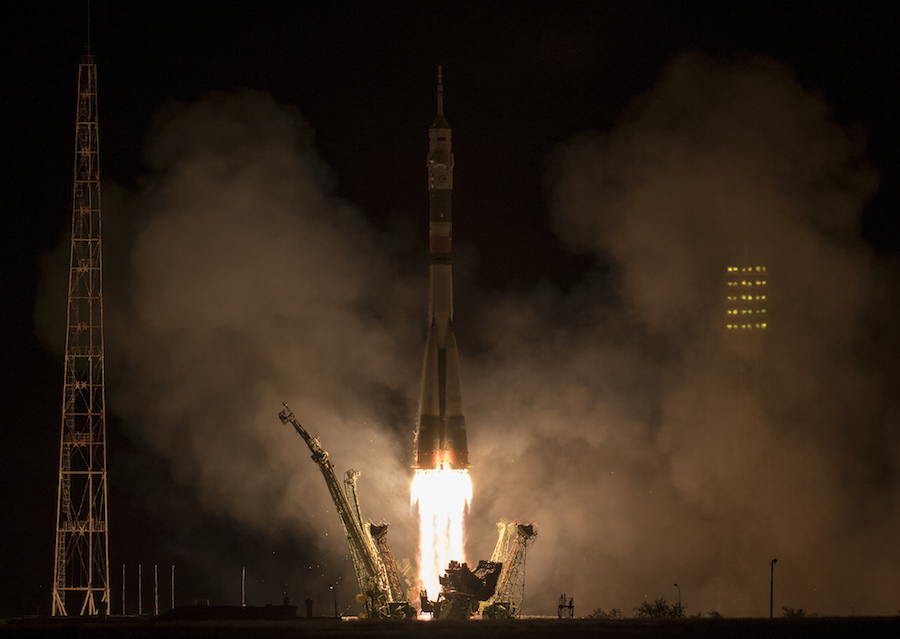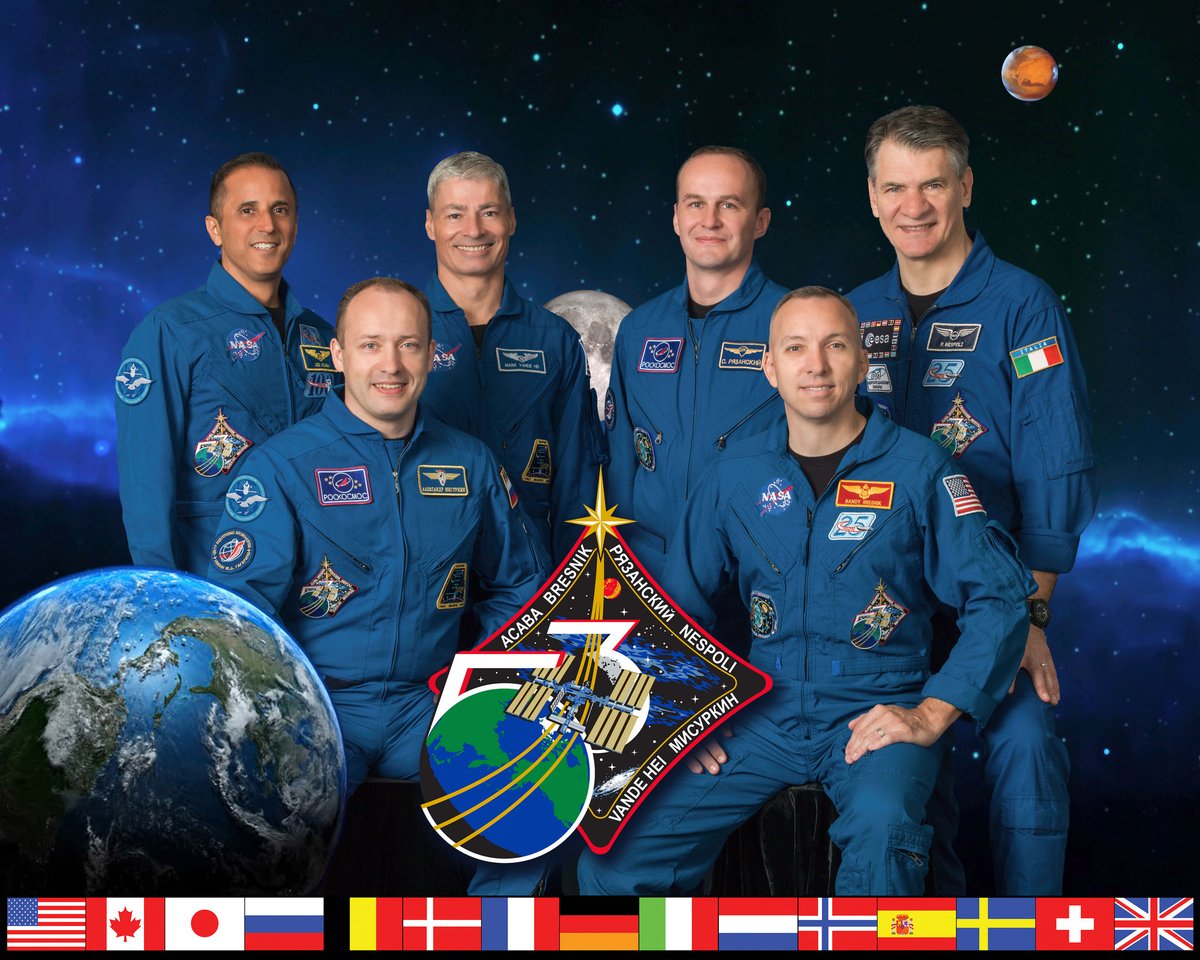STORY WRITTEN FOR CBS NEWS & USED WITH PERMISSION

Lighting up the pre-dawn sky, a Soyuz rocket roared to life and streaked into orbit Tuesday carrying a Russian cosmonaut and two NASA astronauts to the International Space Station, boosting the lab’s crew back to six and the U.S. complement to four NASA-sponsored astronauts.
The expanded U.S. crew takes advantage or near-term Russian downsizing, allowing more time for on-board research in the station’s American-led segment.
Strapped into the Soyuz MS-06 spacecraft, commander Alexander Misurkin, NASA flight engineer Mark Vande Hei and astronaut Joe Acaba blasted off from the Baikonur Cosmodrome in Kazakhstan at 5:17:02 p.m. EDT (GMT-4; 3:17 a.m. Wednesday local time), kicking off a six-hour, four-orbit rendezvous with the space station.
The workhorse Soyuz booster put on a spectacular show, riding a brilliant jet of exhaust into a clear sky. Live video from inside the crew compartment showed Misurkin and his crewmates calmly monitoring cockpit displays as the booster accelerated toward orbit.
Eight minutes and 45 seconds after liftoff, the Soyuz MS-06 spacecraft was released from the booster’s upper stage, antennas deployed and two solar wings unfolded and locked in place as the crew set off after the space station.
Misurkin, making his second trip to the lab complex, rookie Vande Hei and station veteran Acaba executed a smooth six-hour rendezvous, docking at the space station’s upper Poisk module at 10:55 p.m. four orbits after launch.
“Contact! We have mechanical contact,” Misurkin, speaking through a translator, radioed Russian flight controllers as the nose of the Soyuz was captured by the Poisk docking port. “And we have docking mechanism engaged.”
“Great!” a controller replied. “Copy.”
Standing by to welcome Misurkin and his crewmates aboard, after lengthy checks to verify a structurally sound, airtight seal, were Expedition 53 commander Randy Bresnik, cosmonaut Sergey Ryazanskiy and European Space Agency astronaut Paolo Nespoli.

Launched to the station July 28 aboard the Soyuz MS-05 spacecraft, Ryazanskiy, Bresnik and Nespoli have had the lab to themselves since Sept. 2 when Soyuz MS-04 commander Fyodor Yurchikhin, Jack Fischer and Peggy Whitson — NASA’s most experienced astronaut — returned to Earth.
With the arrival of Misurkin, Vande Hei and Acaba, the station once again is fully staffed, with four crew members dedicated to carrying out research in the U.S. segment of the lab.
The space station’s crew normally is evenly split between the Russians and the U.S. segment, with three cosmonauts responsible for the lab’s Russian modules and three astronauts, representing NASA, ESA, Japan and Canada, operating systems and carrying out research in modules supplied by NASA, ESA and Japan.
NASA is responsible for arranging transportation for the station’s non-Russian crew members, known collectively as U.S. Operating Segment — USOS — astronauts.
The Russians decided late last year to downsize their crews in the near term to save money, eliminating one or more Progress supply ships, a decision that freed up seats aboard upcoming Soyuz spacecraft.
At roughly the same time, Boeing and the Russian aerospace company Energia reached a settlement in a $320 million dispute involving the Sea Launch commercial rocket company. As part of the settlement, Boeing obtained two Soyuz seats in 2017 and 2018 with options for three more.
According to Space.com, NASA eventually agreed to buy all five seats for an average cost of $74.7 million each, modifying an existing contract with the Russians.
The two near-term seats will allow NASA to expand the USOS segment of the station crew from three to four and the other seats will serve as insurance in case commercial ferry ships being built by Boeing and SpaceX are delayed, requiring additional Soyuz flights for USOS crew members.
Once the commercial crew ships begin regular flights to the station, the USOS crew again will consist of four astronauts.
Acaba, a former high school teacher and Peace Corps volunteer with master’s degrees in geology and education, won the additional seat on the upcoming mission, joining Vande Hei and Misurkin. While station astronauts typically spend 18 months to two years training for a long-duration stay, Acaba had to get up to speed in just six months.
“Luckily, I’m flying with experienced and very capable crew members,” Acaba told reporters earlier this year. “Before I started (training), NASA and all the international partners got together, they put together a really nice plan on what’s required for me to be safe and also to execute the mission. It’s (been) busy, but fun.”
As for the value of an additional USOS crew member, “I think it’s going to make a huge difference,” he said.
“Right now, having four USOS crew members on board, it gives you a lot more opportunities, not only to maintain the space station but then do the science we’re up there for. I think the number I heard is somewhere around 800 more hours of utilization. That’s a big chunk of science we’re going to be able to do by adding an extra crew member. So it’s pretty cool.”
NASA got a taste of expanded crew operations earlier this summer, taking advantage of an empty seat aboard the Soyuz MS-04 spacecraft that carried Yurchikhin and Fischer into orbit last April. At that time, Whitson was scheduled to come home in early June, but NASA and the Russians agreed to extend her mission by three months, allowing her to join Yurchikhin and Fischer for return to Earth earlier this month.
As a result, four USOS astronauts were aboard the outpost after Ryazanskiy, Bresnik and Nespoli arrived July 28. The Soyuz MS-06 crew will boost the USOS crew back up to four. Another Soyuz scheduled for launch in December will carry two more USOS astronauts to the station, NASA’s Scott Tingle and Norishige Kanai, representing the Japanese space agency.
Misurkin, Vande Hei and Acaba are scheduled to remain aboard the station until Feb. 26. During their stay in space they will welcome one Orbital ATK Cygnus cargo ship, two SpaceX Dragon freighters, two Progress supply ships and will carry out up to three spacewalks to service the station’s robot arm and to carry out routine maintenance.
Along with a full slate of scientific research.
“I’m really looking forward to getting to work,” Vande Hei said. “I’m really excited to live with these gentlemen and the crew that’s going to be on the station when we arrive and the crew that we’re going to receive later in our mission. Frankly, I’m really looking forward to seeing what the view is like.”
And experiencing weightlessness.
“Flying around is the coolest thing ever, you never get tired of that microgravity environment,” Acaba said. “Every morning, I would wake up and float out of my crew quarters and it was just this weird feeling, just to push yourself across the lab. So that’s a whole lot of fun, very relaxing.
“Looking out the window, you have a view you can’t get anywhere else on Earth, so I don’t think we ever get tired of that. But we also have the usual, we watch movies, you have a telephone, you can call your family and friends, just living up there every day is pretty fun.”



